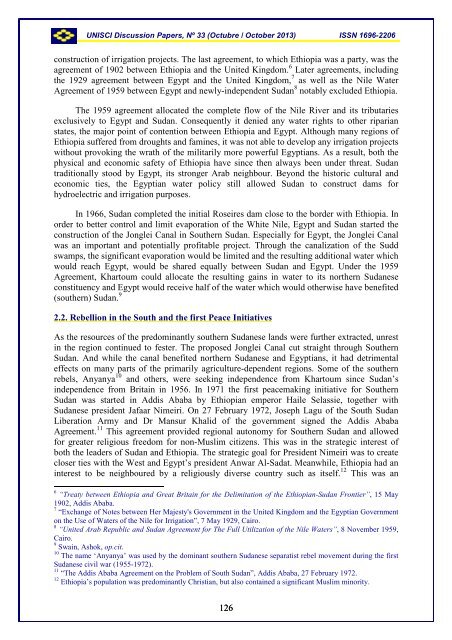UNISCI - Universidad Complutense de Madrid
UNISCI - Universidad Complutense de Madrid
UNISCI - Universidad Complutense de Madrid
Create successful ePaper yourself
Turn your PDF publications into a flip-book with our unique Google optimized e-Paper software.
<strong>UNISCI</strong> Discussion Papers, Nº 33 (Octubre / October 2013) ISSN 1696-2206construction of irrigation projects. The last agreement, to which Ethiopia was a party, was theagreement of 1902 between Ethiopia and the United Kingdom. 6 Later agreements, includingthe 1929 agreement between Egypt and the United Kingdom, 7 as well as the Nile WaterAgreement of 1959 between Egypt and newly-in<strong>de</strong>pen<strong>de</strong>nt Sudan 8 notably exclu<strong>de</strong>d Ethiopia.The 1959 agreement allocated the complete flow of the Nile River and its tributariesexclusively to Egypt and Sudan. Consequently it <strong>de</strong>nied any water rights to other riparianstates, the major point of contention between Ethiopia and Egypt. Although many regions ofEthiopia suffered from droughts and famines, it was not able to <strong>de</strong>velop any irrigation projectswithout provoking the wrath of the militarily more powerful Egyptians. As a result, both thephysical and economic safety of Ethiopia have since then always been un<strong>de</strong>r threat. Sudantraditionally stood by Egypt, its stronger Arab neighbour. Beyond the historic cultural an<strong>de</strong>conomic ties, the Egyptian water policy still allowed Sudan to construct dams forhydroelectric and irrigation purposes.In 1966, Sudan completed the initial Roseires dam close to the bor<strong>de</strong>r with Ethiopia. Inor<strong>de</strong>r to better control and limit evaporation of the White Nile, Egypt and Sudan started theconstruction of the Jonglei Canal in Southern Sudan. Especially for Egypt, the Jonglei Canalwas an important and potentially profitable project. Through the canalization of the Suddswamps, the significant evaporation would be limited and the resulting additional water whichwould reach Egypt, would be shared equally between Sudan and Egypt. Un<strong>de</strong>r the 1959Agreement, Khartoum could allocate the resulting gains in water to its northern Sudaneseconstituency and Egypt would receive half of the water which would otherwise have benefited(southern) Sudan. 92.2. Rebellion in the South and the first Peace InitiativesAs the resources of the predominantly southern Sudanese lands were further extracted, unrestin the region continued to fester. The proposed Jonglei Canal cut straight through SouthernSudan. And while the canal benefited northern Sudanese and Egyptians, it had <strong>de</strong>trimentaleffects on many parts of the primarily agriculture-<strong>de</strong>pen<strong>de</strong>nt regions. Some of the southernrebels, Anyanya 10 and others, were seeking in<strong>de</strong>pen<strong>de</strong>nce from Khartoum since Sudan’sin<strong>de</strong>pen<strong>de</strong>nce from Britain in 1956. In 1971 the first peacemaking initiative for SouthernSudan was started in Addis Ababa by Ethiopian emperor Haile Selassie, together withSudanese presi<strong>de</strong>nt Jafaar Nimeiri. On 27 February 1972, Joseph Lagu of the South SudanLiberation Army and Dr Mansur Khalid of the government signed the Addis AbabaAgreement. 11 This agreement provi<strong>de</strong>d regional autonomy for Southern Sudan and allowedfor greater religious freedom for non-Muslim citizens. This was in the strategic interest ofboth the lea<strong>de</strong>rs of Sudan and Ethiopia. The strategic goal for Presi<strong>de</strong>nt Nimeiri was to createcloser ties with the West and Egypt’s presi<strong>de</strong>nt Anwar Al-Sadat. Meanwhile, Ethiopia had aninterest to be neighboured by a religiously diverse country such as itself. 12 This was an6 “Treaty between Ethiopia and Great Britain for the Delimitation of the Ethiopian-Sudan Frontier”, 15 May1902, Addis Ababa.7 “Exchange of Notes between Her Majesty's Government in the United Kingdom and the Egyptian Governmenton the Use of Waters of the Nile for Irrigation”, 7 May 1929, Cairo.8 “United Arab Republic and Sudan Agreement for The Full Utilization of the Nile Waters”, 8 November 1959,Cairo.9 Swain, Ashok, op.cit.10 The name ‘Anyanya’ was used by the dominant southern Sudanese separatist rebel movement during the firstSudanese civil war (1955-1972).11 “The Addis Ababa Agreement on the Problem of South Sudan”, Addis Ababa, 27 February 1972.12 Ethiopia’s population was predominantly Christian, but also contained a significant Muslim minority.126
















